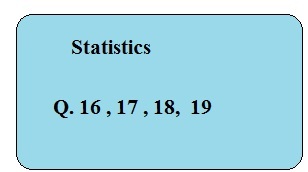Q.1 – Q.2 , Q.3 – Q.4 Q.5 , Q.6 , Q.7 , Q.9 , Q. 10 , Q. 11 Q.12 , Q.13 , Q. 14 , Q. 15 Q.16 to Q. 19
Answer 16
Refer the figure from the book;
Mean = 65 cm.
Total 3000 penguins, , standard deviation = 5cm.
(a).
Number of Penguins with height between 65 to 75 cm .
The difference is 75 – 65 = 10 , i.e. 2 standard deviation above the mean.
Here we will take two ranges of standard deviation = 34 % + 14 % = 48% (See figure in the book)
Hence ,
48 % of 3000
= (3000 x 48 )/ 1000
= 30 x 48
= 1440
(b).
Probability of penguin’s height less than 60 cm.
Our mean is 65 cm. , Standard deviation is 5 cm.,
So penguin’s height lesser than 60 cm. is 65 – 60 = 5 ; 1 deviation below the mean.
Take the values from the figure given in the book = 14 % + 2 % = 16 %
Probability of penguin’s height below 60 cm. is 0.16.
As answer is asked nearest to 0.05
We will round off the value of probability which is 0.16 nearest to 0.15.
Answer 17.
Refer the graph from the book;
(a).
It is very much clear that expenditure in 1998 was 135 billion dollars and in 1997, expenditure is 115 billion dollars
Difference is 135 – 115 = 20 billion dollars, which is highest among all.
So correct answer is 1998.
See the following table also.
| Year | Total Expenditure
( Billion dollars) |
Increase in total expenditure compared to the previous year
(Billion dollars) |
| 1987 | 40 | – |
| 1988 | 42 | 42 – 40 = 2 |
| 1989 | 45 | 45 – 42 = 3 |
| 1990 | 58 | 58 – 45 = 13 |
| 1991 | 65 | 65 – 58 = 7 |
| 1992 | 66 | 66 – 65 = 1 |
| 1993 | 78 | 78 – 66 = 12 |
| 1994 | 88 | 88 – 78 = 10 |
| 1995 | 95 | 95 – 88 = 7 |
| 1996 | 100 | 100 – 95 = 5 |
| 1997 | 115 | 115 – 100 = 15 |
| 1998 | 135 | 135 – 115 = 20 |
| 1999 | 140 | 140 – 135 = 5 |
| 2000 | 149 | 149 – 140 = 9 |
| 2001 | 160 | 160 – 149 = 12 |
( b ).
In 2001 private school expenditure was 30 billion dollars and total expenditure was 160 billion dollars
So,
(30/160)x 100
= 18.75 % nearly equals to 19%
Answer 18.
(a).
25 million = (25/150) x 100
= 16.66 %
We will take all the values greater than 16.66 %
So, the workers in Agriculture , Manufacturing and Clerical categories are above 16.66 %
Hence the answer is ‘Three’.
(b).
Ratio of Agriculture Category in 2001 to Projected numbers in 2015
Number of workers in agriculture category in 2001 = 18% of 150 million
Numbers of workers in agriculture category in 2015 = 24 % of 175 million
Ratio of agriculture woker in 2001 to 2015 = (18 x 150) /(24 x 175)
= 9/14 or 9 to 14
( c ) .
In 2001
Number of workers in Sales = 8% = 8 x 150 = 1200 million
Number of workers in Service = 15% = 15 x 150 = 2250 million
Number of workers in Clerical = 20% = 20 x 150 = 3000 million
In 2015
Number of workers in Sales = 7% = 7x 175 = 1225 million
Number of workers in Service = 16% = 16 x 175 = 2800 million
Number of workers in Clerical = 20% = 18 x 175 = 3150 million
From the above calculation it is clear that there is a increase in number of workers in all the three categories, i.e. I , II , III
Answer 19.
(a).
In 2003, Mortgage ,Insurance and Property Tax + Savings = 24 % + 25% = 49%
In 2004 Mortgage ,Insurance and Property Tax = (27/100) x 45000 = 12150
In 2004 , Savings = (12/100 ) x 45000 = 5400
Total = 12150 + 5400 = $ 17,550
( b).
From the graph we can observe that there is highest percent increase in expenditure in
“MISCELLANEOUS” category which is around
Q.1 – Q.2 , Q.3 – Q.4 Q.5 , Q.6 , Q.7 , Q.9 , Q. 10 , Q. 11 Q.12 , Q.13 , Q. 14 , Q. 15 Q.16 to Q. 19
<<<<<<<<<<<<<<<PREVIOUS PAGE


